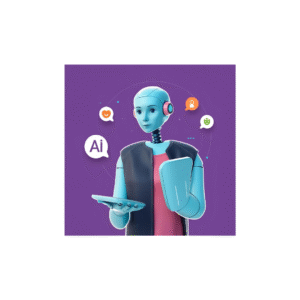In today’s fast-paced, digitally connected world, AI-Powered Chatbots for Mental Health Support are transforming the way people access emotional care. These intelligent digital companions offer 24/7 support, helping individuals manage stress, anxiety, and depression without the stigma or barriers of traditional therapy.
This article delves into how AI chatbots work, their benefits, limitations, and real-world examples, while exploring what the future holds for this powerful intersection of artificial intelligence and mental wellness.

Table of Contents
Toggle1. What Are AI-Powered Chatbots for Mental Health Support?
AI-powered chatbots are virtual agents designed using natural language processing (NLP) and machine learning algorithms. Their primary goal is to simulate human conversation and provide empathetic responses, particularly for those seeking emotional or psychological help.
Unlike conventional apps, AI-Powered Chatbots for Mental Health Support can interact in real-time, detect mood shifts, and respond with personalized suggestions—offering support when it’s needed the most.
2. How Do These Chatbots Work?
AI mental health chatbots work through:
2.1 Natural Language Processing (NLP)
They interpret user input, understand context and emotions, and provide human-like replies.
2.2 Machine Learning
With every interaction, chatbots improve. They adapt their responses to better match user behavior and preferences.
2.3 Pre-trained Psychological Models
Many chatbots are designed in consultation with psychologists, allowing them to replicate cognitive behavioral therapy (CBT) techniques in conversation.
3. Benefits of Using AI Chatbots for Mental Health
3.1 24/7 Accessibility
One of the biggest advantages of AI-Powered Chatbots for Mental Health Support is their round-the-clock availability. Users can seek help anytime, without waiting for appointments.
3.2 Anonymity and Reduced Stigma
Many people are hesitant to reach out to a therapist due to societal pressure. Chatbots offer a judgment-free, anonymous space for emotional release.
3.3 Scalability
Unlike human therapists, chatbots can handle thousands of conversations at once—making mental health support more accessible globally.
3.4 Cost-Effectiveness
While traditional therapy can be expensive, chatbot-based solutions are either free or low-cost, making mental health care more affordable.
4. Real-Life Examples of AI Mental Health Chatbots
4.1 Woebot
Developed by Stanford researchers, Woebot offers CBT-based conversations and daily emotional check-ins.
4.2 Wysa
This AI chatbot blends evidence-based techniques like CBT, dialectical behavior therapy (DBT), and mindfulness to provide emotional support.
4.3 Replika
Although not strictly a mental health chatbot, Replika helps users talk through emotions and practice self-reflection in a conversational format.
These examples highlight the evolving effectiveness of AI-Powered Chatbots for Mental Health Support in helping users cope with everyday psychological challenges.
5. Limitations and Ethical Considerations
5.1 Not a Replacement for Human Therapists
While AI chatbots provide valuable assistance, they aren’t a replacement for professional therapy—especially for severe conditions.
5.2 Data Privacy Concerns
As these chatbots handle sensitive information, developers must ensure robust security measures to protect user data.
5.3 Emotional Misinterpretation
Despite advances, chatbots may still misread emotional cues, leading to potentially unhelpful or even harmful advice.
6. The Future of AI in Mental Health Support
As technology evolves, AI-Powered Chatbots for Mental Health Support are expected to become even more intelligent and emotionally aware. Integration with wearable health tech, personalized mental wellness plans, and multilingual capabilities are just some advancements on the horizon.
With responsible development and ethical considerations in place, these digital allies could become a core component of mainstream mental healthcare.
Conclusion
AI-Powered Chatbots for Mental Health Support are proving to be revolutionary tools in bridging the mental health care gap. They offer immediate, private, and scalable support to those who might otherwise go unheard. While not a complete substitute for traditional therapy, they serve as a critical first step in seeking help—and that alone makes them invaluable in today’s world.
Also Read: Deep Learning Applications of AI in Radiology
Also Read : Best AI Skincare Tools 2025
Pingback: Best AI Skincare Tools 2025 - aifirstpost.com